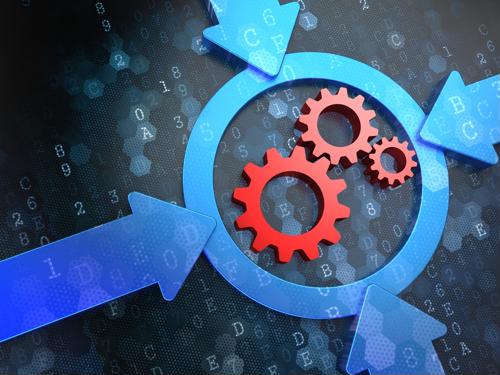Hyperautomation represents all of a company’s automation efforts, effectively managed through a single system. This approach helps to direct resources, discover opportunities and develop the best possible strategy for effective, beneficial use of automation platforms.
The value of automation in the business world is already clear. Robotic process automation (RPA), artificial intelligence (AI), machine learning and similar tools save time, increase efficiency, bring order to data flows and allow staff to dedicate their time to areas where uniquely human skills like critical thinking and interpersonal communication are needed. A successful hyperautomation journey and accompanying strategy helps organizations get the most out of their investment into automation and continue to identify new areas where it can be applied.
 Hyperautomation scales the benefits of automated tools to bring more value to your business.
Hyperautomation scales the benefits of automated tools to bring more value to your business.What is hyperautomation?
We have already provided a brief and functional definition of hyperautomation: a process that brings all automation efforts together and, through improved insight and analysis, helps extend the capabilities of automation tools. Another key element to keep in mind, as TechTarget pointed out, is the ability of hyperautomation to increase organizational agility and enhance the potential for quick, effective decision-making.
With the right enterprise automation tools in place, your business can leverage them to the fullest extent. That means more than just applying automation to specific repetitive tasks. Hyperautomation, when properly implemented and managed, empowers businesses to reduce operational costs, organize unstructured data and leverage advanced analytics to work smarter across the board. Over time, subsequent automation opportunities may be uncovered, resulting in an “automation anywhere” environment in which entire business units benefit from, for example, RPA implementation or similar digital transformation. Working interdependently or layered together, intelligent automation tools redefine the nexus of technology and business.
RPA in particular is an incredibly useful platform that offers measurable, positive outcomes, like completing time-consuming, menial work faster or freeing up expensive labor. At the same time, it applies to specific tasks and, unless expanded or repurposed, has a limited scope in terms of where and how it can be effective. Hyperautomation is a much broader concept that positions automation resources to support a wider variety of objectives and equip staff with the knowledge, context and analysis that leads to better decisions.
What are the benefits of hyperautomation?
As Gartner pointed out, a company’s hyperautomation effort is ultimately designed to improve and enhance decisions made by employees. An ideal hyperautomation solution will also incorporate AI decision-making into business operations, allowing staff to focus on areas where a human touch is needed.
Human knowledge, experience and skills are uniquely valuable in the business world, and despite the increasing power of automated tools, will likely remain that way for a substantial amount of time. The challenge for many businesses is allocating these resources effectively. Basic automation helps solve this problem, putting RPA, AI and other tools to work on tasks that otherwise consume valuable employee time and effort.
A fully realized hyperautomation effort will provide deep insight that augments human decision-making while also allowing AI to make choices and decide on specific actions as appropriate. While the specifics will change significantly in terms of the types of automation technology used from one industry to the next and even between individual companies in the same market, the advantages are clear.
How is hyperautomation different from automation?
In general, hyperautomation is a more sophisticated tool than traditional automation. It extends the range of applications where automated processes like RPA and AI can support business efforts. Most critically, it combines all automation efforts into a single organized structure that is more effectively managed over time.
Automation by itself generally addresses a discrete task, which may be sizeable, time-consuming or otherwise cumbersome to complete. Hyperautomation offers a path toward scaling automation efforts. It brings all of the tools and processes used into one place while offering additional insight. This sets the conditions for more widespread and complex automation use cases. The end goal of a hyperautomation platform is not to address a specific need or task, but to provide the capability to scale automation and increase the value these tools offer to a business in a holistic manner.
How can my organization achieve hyperautomation?
Hyperautomation is not a turnkey process. No business can implement effective automation tools, build the structures needed to bring them together and then achieve effective hyperautomation in a short period of time. The good news is that many companies have already started this process by implementing some form of automation. With effective tools already working to provide specific results, it’s that much easier to move into hyperautomation and realize stronger, more wide-ranging benefits across an organization.
Just as automation requires specific software to reliably execute tasks automatically, a hyperautomation journey benefits greatly from a management solution designed to help companies reach this goal. Combining all streams of data related to automation in a single application improves insight and analysis, providing an incredibly valuable single source of truth for achieving hyperautomation. With all of the necessary information at hand, it’s much easier to track progress, identify opportunities and find the best path forward to hyperautomation.
The type of management application your organization selects can have a major influence on the success of hyperautomation efforts – and, by extension, your company’s ability to remain agile and effective in the future. While this is a relatively new area for all but the largest and most advanced businesses, selecting the right solution for hyperautomation software needs shouldn’t feel overwhelming. Conducting research, viewing demos, discussing how providers have helped similar companies achieve success with their software and carefully comparing available solutions all play a role, just as they do for many other types of important purchases.
When your business makes the decision to strive for hyperautomation as a company-wide goal, make sure you start things off on the right foot. Select the best possible management application and leverage it to assist you in achieving this critically valuable business objective.
Shibumi enables your hyperautomation efforts
Shibumi’s RPA Accelerator is carefully designed to provide specific, valuable and wide-ranging insight, analysis and support for your hyperautomation efforts. To learn more about how our solution can empower your business, schedule a free self-guided demo today.

